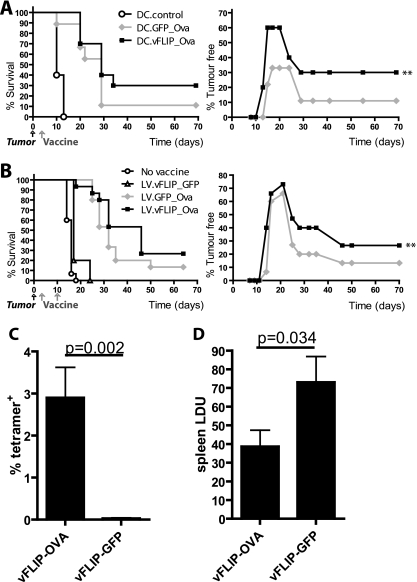FIG. 5.
A vFLIP vaccine induces therapeutic antitumor immunity and protection against Leishmania infection. Mice were challenged with 2 × 106 EG7.OVA tumor cells before s.c. vaccination. Kaplan-Meier survival curves and percentages of tumor-free mice (plotted over time until day 70) are shown. **, P < 0.01. (A) The vaccine was 106 DCs, transduced with the stated vectors or nontransduced (DC.control), and administered 3 days after tumor challenge (n = 10 except for the DC.GFP_Ova group, where n = 9). (B) The vaccine was 1 × 107 i.u. of the lentivectors (LVs), injected at 3 days and 10 days after tumor challenge (n = 15 except in the vFLIP_GFP group, where n = 5). The significance of differences was analyzed using the Wilcoxon signed rank test and the χ2 test. After injection of transduced DCs, the number of tumor-free mice in the vFLIP group was significantly higher than that in the GFP group (P = 0.0078). After direct vector injection, the number of tumor-free mice was significantly higher in the vFLIP group than in the GFP group (P = 0.0039), and survival was significantly improved in the vFLIP group (χ2 = 4.62, P = 0.0316), whereas it was not in the GFP group (χ2 = 2.14, P = 0.1435). (C) Mice were immunized with 1 × 107 i.u. of the lentivectors and then bled after 7 days for tetramer staining of peripheral blood lymphocytes. (D) The same mice were infected with 2 × 107 amastigotes of OVA-L. donovani 8 days after lentivector immunization, and the spleen parasite burden was assessed after a further 28 days. Data were analyzed using a one-tailed t test (n = 5 mice per group). Error bars indicate standard deviations.

